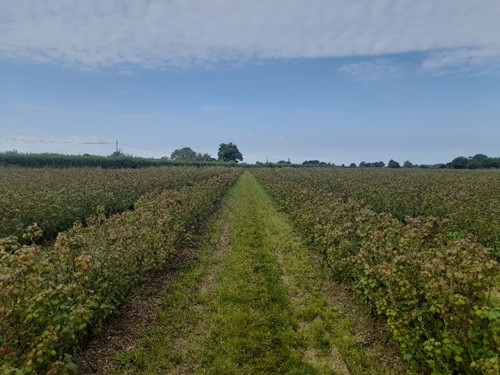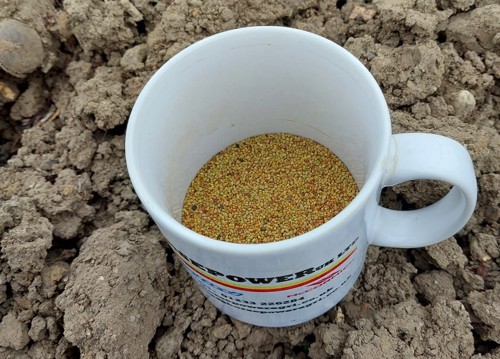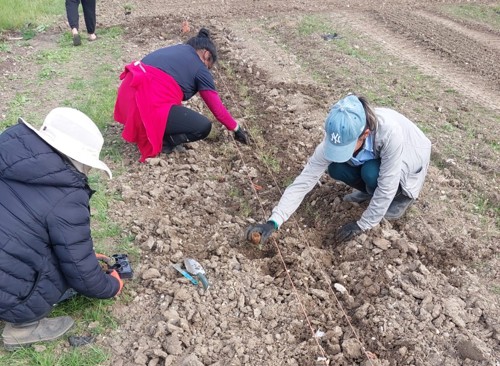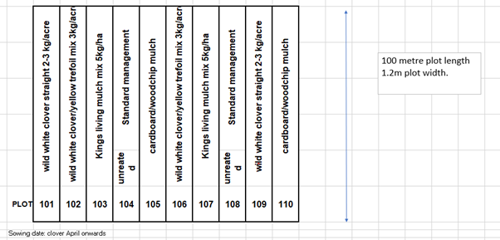This group of commercial blackcurrant growers are exploring living mulches as an alternative weed control method to reduce herbicide use.
The objective of the trial is to test a range of different living mulch species/ mixes to determine if they could offer a viable alternative method of weed control in bush and cane fruit.
This field lab has been instigated by blackcurrant growers Ltd.’s R&D committee.
The benefits
Reducing or removing herbicides from the system offers the potential to significantly improve soil health and all the knock on benefits this could infer to crop health and resilience. There is also a scarcity of new chemistry available for such a minor crop and the potential losses of some of the main herbicides currently used.
Previous work on weed suppression from living mulches under blackcurrants identified that certain species were effective for weed suppression with minimal yield reductions of the cash crop.
The trials would test:
• Efficacy of weed suppression
• % ground cover of living mulch species (short and long term)
• Effect on blackcurrant crop yield and vigour
• Evaluation species / species mixes suitability
Interim results
Key conclusions/notes to date:
The woodchip provided a good level of weed suppression which was very visual at the time of assessment in July 2024.
The wild white clover has established well, but the trefoil establishment was poor.
The soil conditions were very dry in July and perhaps the establishment on the living mulch species were affected by dry conditions at sowing.
It is difficult to sow seeds into the base of the mature blackcurrant crop as cultivation of that area below the bush is difficult.
The treatments will continue to be monitored but a decision needs to be made as to whether more living mulch seed should be sown in early spring 2025.

Full interim report can be found by clicking on the results and reports tab on brown banner above
Treatments set up following weather delays
Triallist Josh Berry was busy on his farm in Kent this week getting the trial plots ready, after poor weather last spring delayed the trial for a year.
Josh is establishing his mulches before planting bushes into them later in the year. Other triallists are setting up the trials in the rows of established blackcurrants.
Treatment 1: woodchip mulch

The first load of woodchip is brought on site

Treatment 2: micro-leafed wild clover living mulch

The field is prepped and ready for sowing the micro-leafed clover

Treatment 3: creeping thyme and chamomile plugs

Dry soil meant the plugs had to be irrigated after planting. The creeping thyme and chamomile plugs are more expensive to buy and more labour-intensive to plant than the clover seed, so Josh is only trialing a small area to see whether they work as weed suppressants. Both varieties can be bought and sown as seed but take a long time to establish, so for the purpose of the trial they were bought as plugs.
Trial designed finalised and species mix agreed
The trial will be carried out on three sites.
Site 1: Josh Berry, Faversham, Kent (living mulch drilled prior to planting of blackcurrant crops)
Site 2: Rosie Begg, Dereham, Norfolk (living mulch drilled into young, already established blackcurrant plantation). At site 2 two soil samples will be taken at the beginning and end of the trial to measure the impacts of the living mulch on the soil bacteria:fungi ratio.
Site 3: James Wright, Kington, nr Hereford (living mulch drilled into young, already established blackcurrant plantation)
Trials will focus on living mulches both pre-planting and in young established plantations.
Trials would have an untreated control, standard herbicide management, 2-3 main species) of living mulch. All treatments will be replicated twice. Plot length will be approximately 100m.
In addition to the main living mulch species two of the growers (site 1 and 2) are keen to experiment with a woodchip and a cardboard/woodchip mulch as additional treatments, following on from the ‘Alternatives to plastic mulch’ field lab (https://www.innovativefarmers.org/field-lab?id=3fcc0fc7-ce4c-ea11-817e-005056ad0bd4)
Alongside these main treatments we will experiment with some smaller plots (10 metre length) of a few novel candidate living mulch species.
Assessments would measure percentage living mulch and weed cover, blackcurrant vigour, yield assessment and the information would be summarised in a final report.

· 1.2-2m wide x c.100 m long plots
· X2 replications and/or multiple monitoring locations up the row to add replication
· Species mixes/Sowing densities – to be guided by seed merchants
· Growers also keen to experiment with wood and cardboard mulches and lesser used species e.g creeping thyme, creeping cinquefoil, chewings fescue. These would be sown on smaller plots and just assessed for weed counts and vigour of blackcurrant growth and NOT yield
· Whole row plots - machine harvest to calculate any yield differential
Main living mulch species
· Kings living mulch mix (20% yellow trefoil, 50% white clover, 10% small leaved clover)
· Wild white clover (3kg/ha)
· Wild white clover + yellow trefoil (3kg/ha)
Novel candidate living mulch species to be trialled in smaller plots to assess suitability as a living mulch
· Creeping thyme – Thymus serpyllum
· Yarrow - Achillea millefolium
· Bugle – Ajuga reptans
· Creeping cinquefoil – Potentilla reptans
· Lobelia angulate
The weed assessments, data analysis and reporting will be done by ADAS. All ground preparation, sowing of living mulches and any other treatments (bio-mulch/woodchips) will be done by the growers at no additional cost to the project. The assessment timings are detailed in the milestones section of the proposal.
April 2023
|
Living mulch species sown at sites by the growers |
Spring/Summer 2023
Species mown to encourage species to spread on living mulch sown prior to planting the plantation
May/August 2023
Percentage living mulch cover, weed count, blackcurrant vigour assessment at established plantations. Assessments to be carried out by ADAS
November 2023 - March 2024
Blackcurrant cuttings planted by grower.
May/June 2024
Weed counts and blackcurrant vigour assessment by ADAS staff
July 2024
Harvest
August 2024
Yield data analysis and interim report by ADAS
November 2024-March 2025
Cuttings cut back to initiate branching by grower
Summer 2026
Weed counts and blackcurrant vigour assesment by ADAS staff
July 2026
Harvest and yield assessment (site 1)
August 2026
Data analysis and report by ADAS staff
Group Coordinator

Harriet Prosser
Suntory Beverage and Food GB&I
Harriet is employed by Ribena’s owners SBF GB&I to support the UK blackcurrant industry. SBF GB&I contracts 34 farms across the UK totalling just over 2000 ha of blackcurrants this represents over 90% on the UK blackcurrant industry all of which goes to make Ribena. Ribena is committed to sourcing 100% UK grown blackcurrants and to ensure that is the case now and in the future Harriet’s job is to look ahead and to target research and development for the benefit of the industry and the security of the supply chain.
Farmers

Josh Berry
Gushmere Court Farm
Kent

Rosie Begg
Gorgate Ltd, Nr Dereham
Norfolk
Researchers

Kevin Godfrey
ADAS

Dr Lynn Tatnell
ADAS
Downloadable Reports
Living Mulch Update Norfolk Site 2 November 2024
Press articles and blogs
